Abstract
Background and Purpose
Methods
Results
Supplementary materials
Supplementary Table 1.
Supplementary Figure 1.
Supplementary Figure 2.
Supplementary Figure 3.
Supplementary Figure 4.
Supplementary Figure 5.
Supplementary Figure 6.
Supplementary Figure 7.
Supplementary Figure 8.
Supplementary Figure 9.
Supplementary Figure 10.
Supplementary Figure 11.
Supplementary Figure 12.
Notes
Conflicts of interest
DFK holds equity in Nested Knowledge, Superior Medical Editors, and Conway Medical, Marblehead Medical; a consultant for MicroVention, Medtronic, Balt, and Insera Therapeutics; Data Safety Monitoring Board for Vesalio; and receiving royalties from Medtronic. RK is contracted/consultant for Cerenovus Inc, Medtronic, Endovascular Engineering, Frontior Bio, Sensome Inc, Endomimetics, Ancure LLC, Neurogami Medical, MIVI Biosciences, Monarch Biosciences, Stryker Inc, Conway Medical, Pireus Medical, and Bionau Labs. All remaining authors have declared no conflicts of interest.
Author contribution
Conceptualization: SG, RK, DFK. Study design: SG, MA, AH. Methodology: AH, PV, PJ. Data collection: MA, AH, CB. Investigation: MA, AH, CB. Statistical analysis: PV, PJ, SG. Writing—original draft: MA, AH, PV, PJ. Writing—review & editing: AH, SG, CB. Funding acquisition: NA. Approval of final manuscript: all authors.
ACKNOWLEDGMENTS
References
Figure 1.
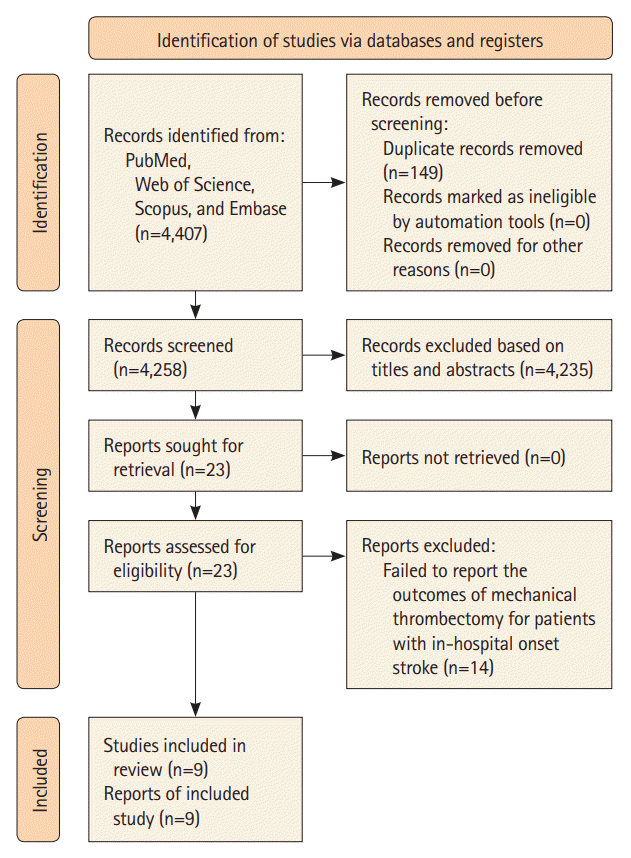
Figure 2.
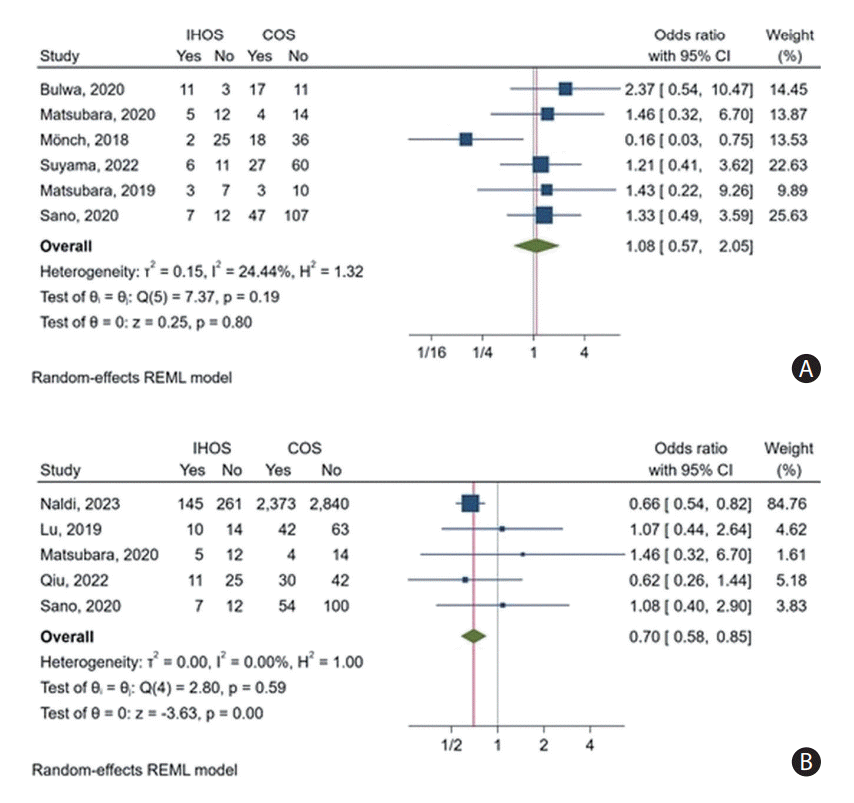
Figure 3.
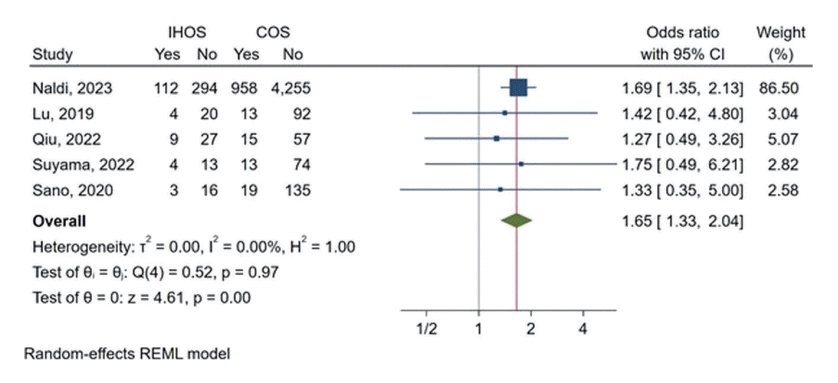
Figure 4.
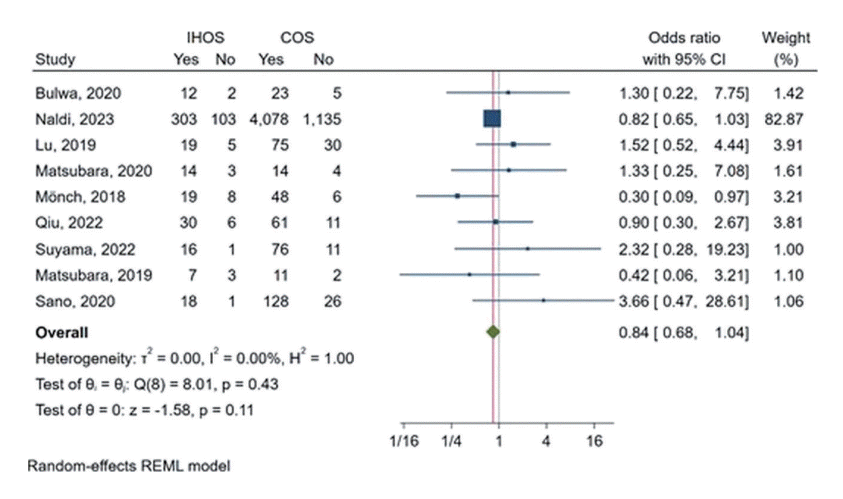
Figure 5.
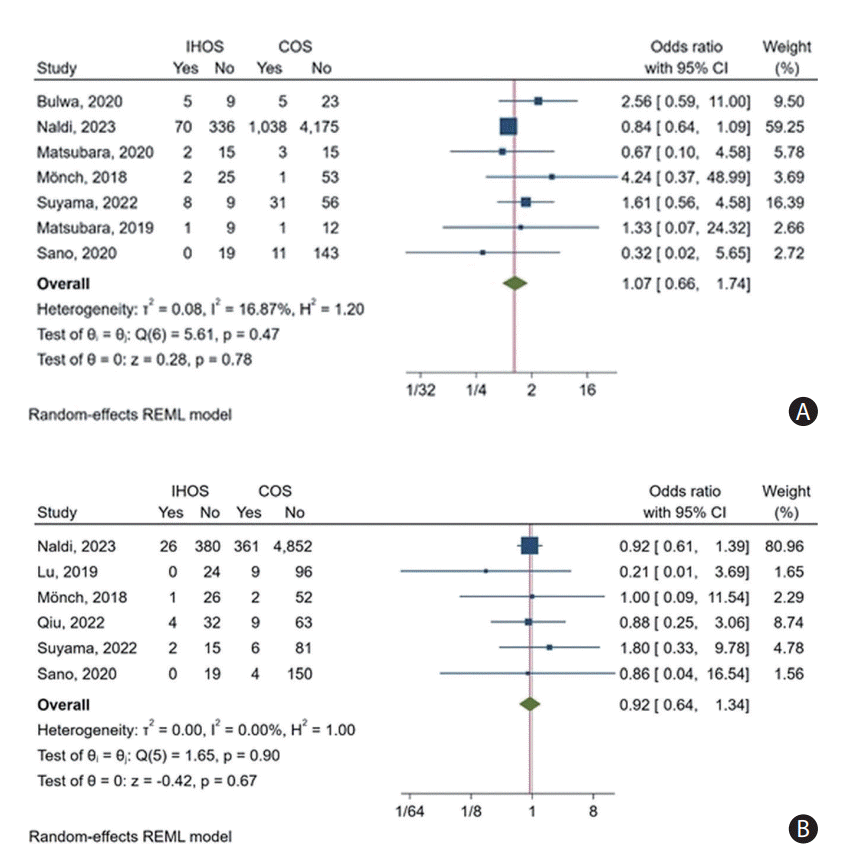
Table 1.
| Study | Study design | Patients (IHOS|COS), n | Age (yr) | Female sex (%) (IHOS|COS) | PMH and DH in IHOS group (%) | PMH and DH in COS group (%) | Stroke mechanism in IHOS group (%) | Stroke mechanism in COS group (%) | Occlusion site in IHOS group (%) | Occlusion site in COS group (%) |
|---|---|---|---|---|---|---|---|---|---|---|
| Bulwa, 2020 [4] | Case-control | 14|28 | IHOS: 58 (median); 48–69 (IQR) | 79|64 | HTN: 64, HLP/DLP: 36, DM: 21, AF: 14, CHF: 43, MLG: 29 | HTN: 79, HLP/DLP: 21, DM: 29, AF: 36, CHF: 25, MLG: 7 | LAA: 7, CEMB: 43, POP: 29, Other: 21 | LAA: 18, CEMB: 46, Undetermined: 21, Other: 14 | ICA: 14, M1 of MCA: 57, M2 of MCA: 21, and BA 7 | NS |
| COS: 68 (median); 57–78 (IQR) | ||||||||||
| Naldi, 2023 [3] | Retrospective cohort | 406|5,213 | IHOS: 73.8 (median); 65.1–80.5 (IQR) | 47.5|51.9 | HTN: 60.9, HLP/DLP: 23.6, DM: 20.5, AF: 39.4, CHF: 14.9, CAD: 17.6, STR: 17.1, SMK: 17.8, MLG: 11.3, APL: 37.2, ACG: 27.6 | HTN: 66.1, HLP/DLP: 23.8, DM: 17, AF: 34, CHF: 6.9, CAD: 10.4, STR: 3.1, SMK: 16.5, MLG: 5.2, APL: 24.9, ACG: 14.2 | LAA: 16.6, CEMB: 56.6, HCG: 3.6, POP: 7.6, Undetermined: 10.3, Other: 5.3 | LAA: 19, CEMB: 53.1, HCG: 1.3, POP: 0.1, Undetermined: 22.2, Other: 4.1 | ICA: 13.5; Carotid T: 11.5; M1 of MCA: 44.8; M2 of MCA: 12.3; Tandem: 3.8; Posterior circulation: 14.2 | ICA: 11.2; Carotid T: 13.2; M1 of MCA: 47.6; M2 of MCA: 12.8; Tandem: 5.4; Posterior circulation: 9.8 |
| COS: 75.5 (median); 64.9–82.2 (IQR) | ||||||||||
| Lu, 2019 [1] | Retrospective cohort | 24|105 | IHOS: 70.1 (mean); 14.1 (SD) | 45.8|53.3 | HTN: 41.7, HLP/DLP: 20.8, DM: 29.2, AF: 33.3 STR: 20.8, SMK: 8.3, MLG: 29.2, APL: 20.8, ACG: 8.3 | HTN: 60.9, HLP/DLP: 30.4, DM: 22.9, AF: 67.6 STR: 26.7, SMK: 5.7, MLG: 8.6, APL: 30.4, ACG: 11.4 | LAA: 8.3, CEMB: 66.7, Undetermined: 4.2, Other: 20.8 | LAA: 12.4, CEMB: 76.2, Undetermined: 7.6, Other: 2.9 | ICA: 29; M1 of MCA: 63; M2 of MCA: 8 | ICA: 22.9; M1 of MCA: 50.5; M2 of MCA: 13.3; ACA: 1; Vertebro-basilar artery: 12.4 |
| COS: 72.9 (mean); 12.2 (SD) | ||||||||||
| Matsubara, 2020 [20] | Retrospective cohort | 17|18 | IHOS: 76.4 (mean); 10.2 (SD) | 29.4|38.8 | NS | NS | LAA: 11.7, CEMB: 64.7, POP: 5.8, Other: 17.6 | LAA: 33.3, CEMB: 55.5, Other: 11.1 | ICA: 29.4; MCA: 58.8; BA: 5.8; PCA: 5.8 | ICA: 33.3; MCA: 55.5; BA: 5.5; ICA+MCA: 5.5 |
| COS: 76.3 (mean); 11.7 (SD) | ||||||||||
| Mönch, 2018 [18] | Case-control | 27|54 | IHOS: 71 (median); 58, 90 (range) | 66|59 | NS | NS | NS | NS | BA: 4; Proximal ICA: 11; Distal ICA: 18; MCA: 63; Tandem: 4 | BA: 4; Proximal ICA: 11; Distal ICA: 18; MCA: 63; Tandem: 4 |
| COS: 75 (median); 40, 96 (min, max) | ||||||||||
| Qiu, 2022 [6] | Case-control | 36|72 | IHOS: 65.9 (mean); 11.5 (SD) | 47.2|44.4 | HTN: 58.3, DM: 19.4, AF: 41.7, CAD: 33.3, MLG: 25, APL: 19.4, ACG: 11.1 | HTN: 55.6, DM: 23.6, AF: 45.8, CAD: 22.2, MLG: 2.8, APL: 18.1, ACG: 9.7 | LAA: 38.9, CEMB: 50, Undetermined: 5.6, Other: 5.6 | LAA: 36.1, CEMB: 56.9, Undetermined: 5.6, Other: 1.4 | ICA, T/L: 50; M1 of MCA: 41.7; M2 of MCA: 8.3 | ICA, T/L: 47.2; M1 of MCA: 48.6; M2 of MCA: 4.4 |
| COS: 66.5 (mean); 14.4 (SD) | ||||||||||
| Suyama, 2022 [2] | Retrospective cohort | 17|87 | IHOS: 76.6 (mean); 8.3 (SD) | 29.4|48.3 | HTN: 88.2, HLP/DLP 47.1, DM: 29.4, AF: 41.2, CAD: 29.4, SMK: 76.5, ACG: 29.4 | HTN: 79.3, HLP/DLP: 46, DM: 24.1, AF: 64.4, CAD: 11.5, SMK: 56.3, ACG: 20.7 | LAA: 5.9, CEMB: 52.9, Undetermined: 17.6, Other: 23.5 | LAA: 11.5, SAA: 73.6, Undetermined: 13.8, Other: 13.8 | ICA: 29.4; M1 of MCA: 29.4; M2 of MCA: 29.4; Posterior circulation: 11.8 | ICA: 25.2; M1 of MCA: 47.1; M2 of MCA: 20.7; Posterior circulation: 6.9 |
| COS: 74.6 (mean); 12.8 (SD) | ||||||||||
| Matsubara, 2019 [5] | Retrospective cohort | 10|13 | IHOS: 78.6 (mean); 5, 92 (min, max) | 40|38.4 | CAD: 80, MLG: 40 | NS | CEMB: 80, HCG: 10, POP: 10 | CEMB: 63 | ICA: 50; MCA: 30; BA: 10; PCA: 10 | ICA 30.7; MCA 53.8; BA: 7.6; ICA+MCA: 7.6 |
| COS: 78.3 (mean); 45, 87 (min, max) | ||||||||||
| Sano, 2020 [19] | Retrospective cohort | 19|154 | IHOS: 81 (median); 76–86.5 (IQR) | 52.7|53.3 | CAD: 21.1, MLG: 26.3 | NS | CEMB: 78.9 | CEMB: 77.3 | ICA 26.3; M1 of MCA: 47.4; M2 of MCA: 15.8; Others: 10.5 | ICA: 24.7; M1 of MCA: 39.6; M2 of MCA: 22.7; Others: 13 |
| COS: 80 (median); 73–85 (IQR) |
IHOS, in-hospital onset stroke; COS, community-onset stroke; PMH, past medical history; DH, drug history; IQR, interquartile range; HTN, hypertension; HLP/DLP, hyperlipidemia/dyslipidemia; DM, diabetes mellitus; AF, atrial fibrillation; CHF, congestive heart failure; MLG, malignancy; LAA, large artery atherosclerosis; CEMB, cardio-embolism; POP, peri-operative; ICA, internal carotid artery; MCA, middle cerebral artery; BA, basilar artery; NS, not specified; CAD, coronary artery disease; STR, stroke; SMK, smoking; APL, anti-platelet; ACG, anti-coagulant; HCG, hyper-coagulability; PCA, posterior cerebral artery; SD, standard deviation.
Table 2.
| Study | Patients (IHOS|COS), n | Admission NIHSS | ASPECTS | Time checkpoints in IHOS cases (min) | Time checkpoints in COS cases (min) | Mechanical thrombectomy device/technique (%) (IHOS|COS) | Periprocedural measures and outcomes (%) (IHOS|COS) | Primary outcomes (%)* |
|---|---|---|---|---|---|---|---|---|
| Bulwa, 2020 [4] | 14|28 | IHOS: 15 (median); 8–19 (IQR) | NS | OTR: 93 (median); 34–161 (IQR) | OTR: 46 (median); 35–83 (IQR) | Stent retriever: 86|93 | IV-tPA: 21.4|46 | Good outcome on |
| OTP: 248 (medina); 157–370 (IQR) | OTP: 209 (median); 172–326 (IQR) | Direct aspiration first-pass technique: 14|7 | PPC: 35|18 | discharge: 79|61 | ||||
| COS: 15 (median); 11–18 (IQR) | RTI: 60 (median); 33.7–106 (IQR) | RTP: 146 (median); 113–195 (IQR) | SucRec: 86|82 | In-hospital | ||||
| RTP: 160 (median); 77–215 (IQR) | mortality: 7|11 | |||||||
| Naldi, 2023 [3] | 406|5,213 | IHOS: 17 (median); 11–20.5 (IQR) | NS | OTI: 60 (median); 33.7–106 (IQR) | OTI: 123 (median); 89–188.5 (IQR) | Stent retriever: 14.2|18.9 | IV-tPA: 14.5|49 | Good outcome on follow-up: 39|48.5 |
| OTP: 150 (median); 105–220 (IQR) | OTP: 220 (median); 168–294 (IQR) | Thromboaspiration: 47.8|50.7 | PPC: 18.1|20.8 | |||||
| COS: 16 (median); 11–20 (IQR) | RTP: 150 (median); 105–220 (IQR) | RTP: 113 (median); 84–151 (IQR) | Combined: 32.4|28.5 | sICH: 7|7.6 | Mortality on followup: 30.1|19.6 | |||
| Other: 5.6|1.9 | SucRec: 78.3|80.4 | Follow-up: 90 days | ||||||
| Lu, 2019 [1] | 24|105 | IHOS: 19 (median); 14–25 (IQR) | NS | OTR: 101 (median); 55–167 (IQR) | OTR: 76 (median); 36–222 (IQR) | Thrombosuction device (Penumbra System): 54.2|61.9 | IV-tPA: 25|44 | Good outcome on follow-up: 41.7|40 |
| OTI: 114 (median); 95–164 (IQR) | OTI: 140 (median); 93–293 (IQR) | Stent retriever: 8.3|5.7 | sICH: 0|8.6 | |||||
| COS: 19 (median); 15–24 (IQR) | OTP: 192 (median); 136–285 (IQR) | OTP: 217 (median); 153–390 (IQR) | Combined use: 20.8|17.1 | SucRec: 79.2|71.4 | Mortality on followup: 16.7|12 | |||
| OTRec: 241 (median); 156–323 (IQR) | OTRec: 251 (median); 186–400 (IQR) | Others: 16.7|15.2 | Follow-up: 90 days | |||||
| Matsubara, 2020 [20] | 17|18 | NS | IHOS: 6.9 (mean); 2.7 (SD) | OTR: 105 (mean); 147 (SD) | OTR: 110 (mean); 171 (SD) | NS | IV-tPA: 12|22 | Good outcome on discharge and follow-up: 30|23 |
| OTRec: 296 (median); 155 (SD) | OTRec: 412 (mean); 226 (SD) | PPC: 12|17 | ||||||
| COS: 7.9 (mean); 1.3 (SD) | RTP: 166 (mean); 80 (SD) | RTP: 216 (mean); 83 (SD) | SucRec: 82|78 | |||||
| RTRec: 200 (mean); 81 (SD) | RTRec: 275 (mean); 125 (SD) | |||||||
| PTRec: 43 (mean); 22 (SD) | PTRec: 73 (mean); 48 (SD) | |||||||
| Mönch, 2018 [18] | 27|54 | IHOS: 18 (median); 6, 26 (min, max) | NS | OTR: 70 (mean); 60 (SD) | OTR: 128 (mean); 97 (SD) | Stent-retriever or aspiration: 100|100 | IV-tPA: 22|38 | Good outcome on discharge: 7|33 |
| OTI: 107 (mean); 21 (SD) | OTI: 206 (mean); 47 (SD) | PPC: 8|2 | ||||||
| COS: 16 (median); 6, 36 (min, max) | OTP: 177 (mean); 106 (SD) | OTP: 232 (mean); 98 (SD) | sICH: 4|4 | In-hospital mortality: 19|13 | ||||
| OTRec: 207 (mean); 77 (SD) | OTRec: 292 (mean); 109 (SD) | SucRec: 70|89 | ||||||
| Qiu, 2022 [6] | 36|72 | IHOS: 16.9 (mean); 7.5 (SD) | NS | OTI: 113.9 (mean); 73.7 (SD) | OTI: 119.4 (mean); 79.6 (SD) | Stent retriever: 94.4|86.1 | IV-tPA: 13.9|43.1 | Good outcome on follow-up: 30.6|41.7 |
| OTP: 186.1 (mean); 86.4 (SD) | OTP: 198.8 (mean); 88.5 (SD) | Aspiration: 5.6|9.7 | sICH: 11.1|12.5 | |||||
| COS: 18 (mean); 8.4 (SD) | OTRec: 281.4 (mean); 107.7 (SD) | OTRec: 295.7 (mean); 105.3 (SD) | SucRec: 83.3|84.7 | Mortality on followup: 25|20.8 | ||||
| Follow-up: 90 days | ||||||||
| Suyama, 2022 [2] | 17|87 | IHOS: 12 (median); 7–18 (IQR) | IHOS: 9 (median), 7–10 (IQR) | OTR: 60 (median) | OTR: 80 (median) | Stent retriever and aspiration catheter: 100|100 | IV-tPA: 11.8|50.6 | Good outcome on discharge: 35.3|31 |
| OTRec: 299 (median) | OTRec: 274 (median) | PPC: 47.1|36 | ||||||
| COS: 20 (median); 14–25 (IQR) | COS: 9 (median); 8–10 (IQR) | RTI: 36 (median) | RTI: 14 (median) | sICH: 11.8|7 | Mortality on followup: 23.5|14.9 | |||
| RTP: 135 (median) | RTP: 117 (median) | SucRec: 94.1|87.4 | ||||||
| PTRec: 53 (median) | PTRec: 38 (median) | |||||||
| Matsubara, 2019 [5] | 10|13 | IHOS: 16 (median); 7 (IQR) | IHOS: 8.3 (median); 1.6 (IQR) | OTR: 60 (median); 40 (IQR) | OTR: 225 (median); 327.5 (IQR) | Stent-retriever: 50|NS | IV-tPA: 20|23 | Good outcome on discharge: 30|23.1 |
| OTRec: 240 (median); 75 (IQR) | OTRec: 495 (median); 350 (IQR) | Penumbra system: 40|NS | PPC: 10|7.7 | |||||
| COS: 15 (median); 4.5 (IQR) | COS: 7 (median); 2 (IQR) | RTP: 130 (median); 65 (IQR) | RTP: 150 (median); 82.5 (IQR) | Other: 10|NS | SucRec: 70|84.9 | |||
| RTRec: 180 (median); 95 (IQR) | RTRec: 255 (median); 115 (IQR) | |||||||
| PTRec: 35 (median); 25 (IQR) | PTRec: 80 (median); 46.2 (IQR) | |||||||
| Sano, 2020 [19] | 19|154 | IHOS: 21 (median); 16–23 (IQR) | IHOS: 10 (median), 4–10 (IQR) | OTR: 20 (median); 2–70 (IQR) | OTR: 148 (median); 76–422 (IQR) | NS | IV-tPA: 26.3|48.7 | Good outcome on discharge: 36.8|30.5 |
| OTRec: 162 (median); 114–265 (IQR) | OTRec: 295 (median); 216–591 (IQR) | PPC: 0|7.1 | ||||||
| COS: 21 (median); 14–26 (IQR) | COS: 10 (median); 6–10 (IQR) | RTI: 32 (median); 13–41 (IQR) | RTI: 11 (median); 7–14 (IQR) | sICH: 0|2.6 | Good outcome on follow-up: 36.8|35.1 | |||
| RTP: 87 (median); 60–146 (IQR) | RTP: 50 (median); 40–68 (IQR) | SucRec: 94.7|83.1 | ||||||
| RTRec: 125.5 (median); 102–197 (IQR) | RTRec: 134 (median); 100–184 (IQR) | Mortality on followup: 15.8|12.3 | ||||||
| PTRec: 39 (median); 34–75 (IQR) | PTRec: 82 (median); 56–118 (IQR) | Follow-up: 90 days |
*Good outcome on follow-up was defined as a modified Rankin Scale score less than or equal to 2 (mRS ≤2), and successful recanalization (SucRec) was defined as Thrombolysis in Cerebral Infarction (TICI) grade or modified Thrombolysis in Cerebral Infarction (mTICI) grade equal to or bigger than 2b or 3 (TICI/mTICI ≥2b-3). IHOS, in-hospital onset stroke; COS, community-onset stroke; NIHSS, National Institutes of Health Stroke Scale; ASPECTS, Alberta Stroke Program Early CT Score; IQR, interquartile range; NS, not specified; OTR, onset to recognition; OTP, onset to puncture; RTI, recognition to imaging; RTP, recognition to puncture; IV-tPA, intravenous tissue-type plasminogen activator; PPC, periprocedural complications; SucRec, successful recanalization; OTI, onset to imaging; sICH, symptomatic intracranial hemorrhage; OTRec, onset to recanalization; SD, standard deviation; RTRec, recognition to recanalization; PTRec, puncture to recanalization.




 PDF
PDF Citation
Citation Print
Print



 XML Download
XML Download